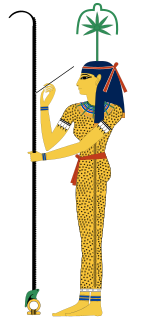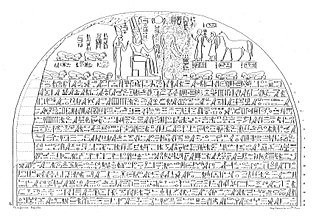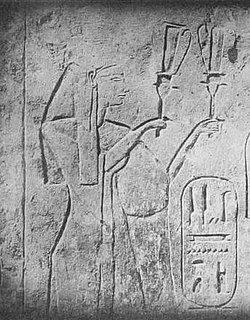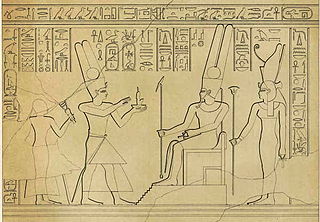
Bastet or Bast was a goddess of ancient Egyptian religion, worshipped as early as the Second Dynasty. Her name also is rendered as B'sst, Baast, Ubaste, and Baset. In ancient Greek religion, she was known as Ailuros.

Meretseger was a Theban cobra-goddess in ancient Egyptian religion, in charge with guarding and protecting the vast Theban Necropolis — on the west bank of the Nile, in front of Thebes — and especially the heavily guarded Valley of the Kings. Her cult was typical of the New Kingdom of Egypt.

Seshat, Ancient Egyptian: sš3t, under various spellings, was the ancient Egyptian goddess of writing, wisdom, and knowledge. She was seen as a scribe and record keeper; her name means "female scribe". She is credited with inventing writing. She also became identified as the goddess of accounting, architecture, astronomy, astrology, building, mathematics, and surveying.

Amenhotep III, also known as Amenhotep the Magnificent or Amenhotep the Great, was the ninth pharaoh of the Eighteenth Dynasty. According to different authors, he ruled Egypt from June 1386 to 1349 BC, or from June 1388 BC to December 1351 BC/1350 BC, after his father Thutmose IV died. Amenhotep was Thutmose's son by a minor wife, Mutemwiya.

Piye was an ancient Kushite king and founder of the Twenty-fifth Dynasty of Egypt, who ruled Egypt from 744–714 BC. He ruled from the city of Napata, located deep in Nubia, modern-day Sudan.

In Ancient Egyptian religion, Taweret is the protective ancient Egyptian goddess of childbirth and fertility. The name "Taweret" (Tȝ-wrt) means "she who is great" or simply "great one", a common pacificatory address to dangerous deities. The deity is typically depicted as a bipedal female hippopotamus with feline attributes, pendulous female human breasts, the limbs and paws of a lion, and the back and tail of a Nile crocodile. She commonly bears the epithets "Lady of Heaven", "Mistress of the Horizon", "She Who Removes Water", "Mistress of Pure Water", and "Lady of the Birth House".

Bintanath was the firstborn daughter and later Great Royal Wife of the Egyptian Pharaoh Ramesses II.

Maathorneferure was an ancient Egyptian queen, the Great Royal Wife of Ramesses II.

Sobekhotep III was an Egyptian king of the Thirteenth Dynasty of Egypt who reigned three to four years, c. 1740 BC or 1700 BC.

Tiy-merenese, Teye-Merenaset, Tiye-Mereniset(Tiy, Beloved of Isis) was the Great Royal Wife of pharaoh Setnakhte and mother of Ramesses III of the Twentieth Dynasty of Egypt.

Iaret was a Great Royal Wife from the middle of the Eighteenth Dynasty of Ancient Egypt.

Ahmose-Henuttamehu was a princess and queen of the late 17th-early 18th dynasties of Egypt.

Heqet, sometimes spelled Heket, is an Egyptian goddess of fertility, identified with Hathor, represented in the form of a frog. To the Egyptians, the frog was an ancient symbol of fertility, related to the annual flooding of the Nile. Heqet was originally the female counterpart of Khnum, or the wife of Khnum by whom she became the mother of Her-ur. It has been proposed that her name is the origin of the name of Hecate, the Greek goddess of witchcraft.
Khenthap was allegedly a queen of Ancient Egypt. She is said to have lived during the 1st Dynasty. Her historical figure is very obscure, since there are no contemporary sources for her name. She appears only once in a much later inscription.
Betrest was a queen of Ancient Egypt. She lived during the First Dynasty.

Isetnofret was a royal woman of Ancient Egypt and, as the Great Royal Wife of Pharaoh Merenptah, she became Isetnofret II.

Abar was a Nubian queen of the Kingdom of Kush dated to the Twenty-fifth Dynasty of Egypt. She is known from a series of stela found in Sudan and Egypt. Her appearances mark her as the niece of King Alara of Nubia, married to King Piye and the mother of King Taharqa.
Nubemhat was an ancient Egyptian queen of the Second Intermediate Period. She was the wife of king Sekhemre Wadjkhaw Sobekemsaf I. She had the title Great Royal Wife and is known from several monuments. A statue with her name and title was found at Kawa in Nubia. She also appears on a stela from Denderah where her daughter, the king's daughter Sobekemheb is mentioned. There also appears the king's son Ameny, son of the queen Haankhes.
Neni was an ancient Egyptian queen of the Thirteenth Dynasty. She was the wife of king Sobekhotep III and the mother of two of his daughters: Iuhetibu Fendy and Dedetanqet. The only title attested for Neni is king's wife, the regular title of queens of this period. Not much else is known about her. There is a stela set up by her steward attesting that Neni had her own estates.
Iuhetibu was an ancient Egyptian king's mother known from several sources as the mother of the 13th Dynasty king Sekhemre-sewadjtawy Sobekhotep, also known as Sobekhotep III, although recent research indicates that he was rather Sobekhotep II. Iuhetibu was the wife of the god's father Mentuhotep. She only appears in sources from the reign of her son. Nothing is known about her life before her son became king. She was the mother of several children. These are king Sobekhotep, the king's son Seneb, the king's son Khakau. Her granddaughter Iuhetibu Fendy, daughter of king Sekhemre-sewadjtawy Sobekhotep was most likely named after her.















